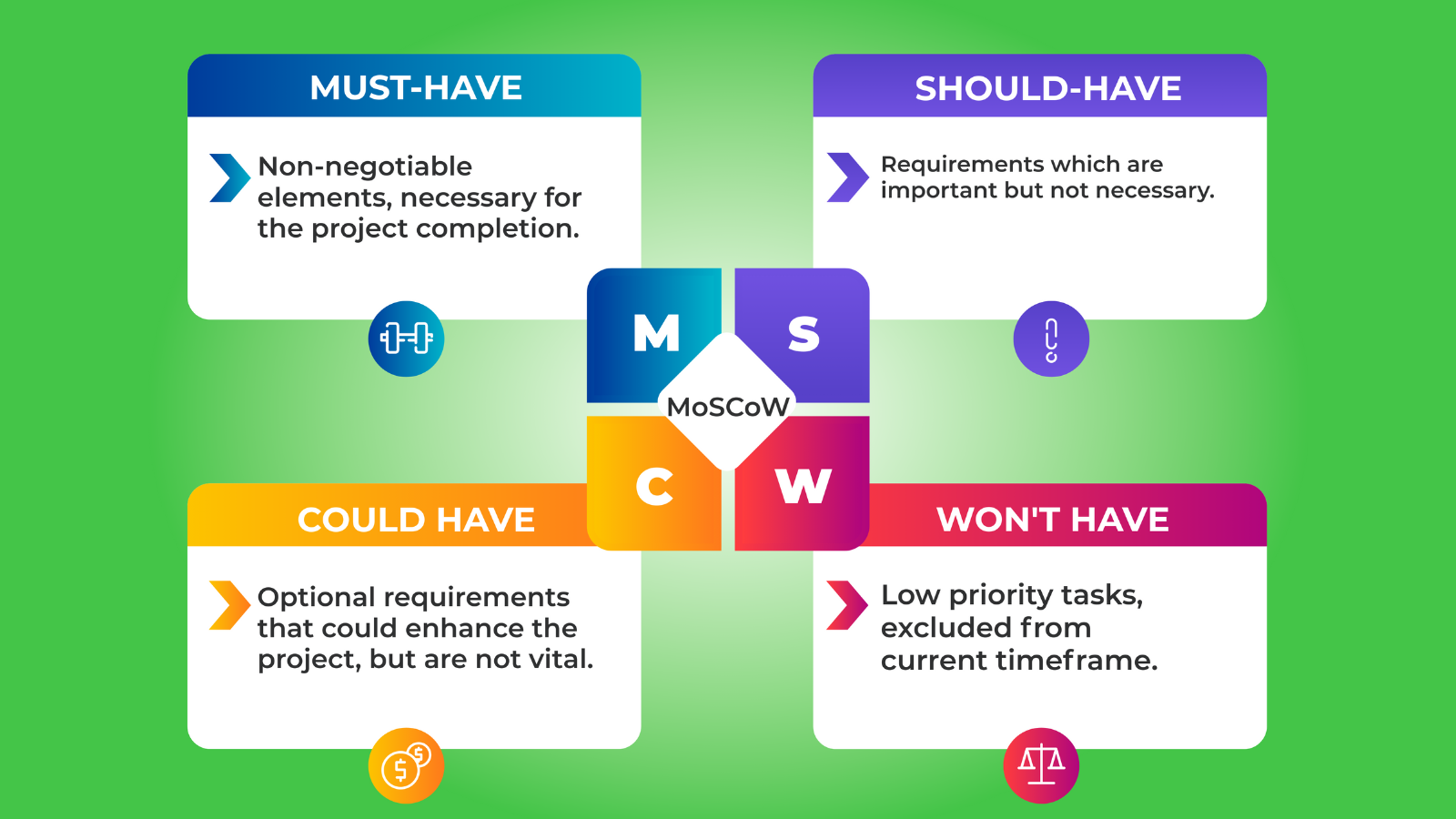Welcome to the world of efficient project management! In today’s fast-paced environment, effectively prioritizing tasks can determine the outcome of a project, whether it succeeds or fails. Picture a scenario where you meticulously organize every task and allocate resources optimally to ensure maximum productivity. That’s where MoSCoW prioritization becomes crucial.
In this detailed guide, we’ll dive into the MoSCoW method of prioritization, revealing its complexities and the secrets to mastering task prioritization. Whether you’re a seasoned project manager or new to project management, this guide will give you essential insights and practical solutions to help you negotiate the complexity of project prioritizing.
Additionally, we’ll touch upon the significance of productivity monitoring tools in enhancing project management efficiency. These tools offer invaluable insights into team performance, task completion rates, and resource utilization, empowering managers to make data-driven decisions and optimize workflow processes.
So, let’s embark on this journey together as we explore the power of MoSCoW prioritization and learn how productivity monitoring tools can complement this method to drive project success.
Hit ‘Play’ Button & Tune Into The Blog!
What Is MoSCoW Prioritization?
MoSCoW prioritization is a method used in project management to categorize tasks based on their importance and urgency. The acronym “MoSCoW” stands for:
- Must-haves
- Should-haves
- Could-haves
- Won’t-haves
This method provides a clear framework for prioritizing tasks, enabling project managers to focus on the most critical aspects of a project while effectively managing resources.
Dai Clegg first introduced the MoSCoW method of prioritization in the early 1990s as part of the Dynamic Systems Development Method (DSDM) framework. It offers a structured approach for prioritizing requirements in agile software development projects.
Over the years, various industries have evolved and adopted the MoSCoW method beyond software development. Its simplicity and effectiveness have made it a popular choice for prioritizing tasks and effective workload distribution in project management, regardless of the industry or project type.
4 Categories In The MoSCoW Prioritization Method
MoSCoW prioritization method classifies project requirements into four distinct categories, each serving a specific purpose in guiding project prioritization and resource allocation:
Must-haves:
Must-haves are the backbone of your project, the non-negotiable elements without which the project loses its essence. These are the top-priority tasks that demand immediate attention. To determine if a requirement belongs in this category, ask yourself: Can the project move forward without completing this task? If the answer is no, then it falls under the must-have category. These tasks are essential for achieving project objectives and delivering meaningful outcomes within the specified timeframe.
Should-haves:
Should-haves indicate important but less urgent requirements than must-haves. These are secondary priorities that contribute to the project’s success; however, the team can handle them later. To identify should-haves, examine whether the team can finish the work later without compromising project progress. If the answer is yes, then it falls under this category. While should-haves are vital, the team does not consider them critical for immediate project execution and can postpone them if necessary.
Could-haves:
Could-haves represent optional requirements that could enhance the project’s scope and functionality but aren’t vital for its success. These tasks act as bonus features, providing additional value if incorporated. However, their omission won’t significantly impact project outcomes. When deciding on whether to include could-haves, assess their potential benefits against the costs and impact on project timelines. If excluding these tasks doesn’t harm other project elements, include them; otherwise, omit them.
Won’t-haves:
Won’t-haves represent tasks explicitly excluded from the current project scope. Project teams consider these requirements low priority and can postpone them to future iterations or projects. While they may hold potential value, they are not essential for achieving project objectives within the given timeframe. Instead of entirely eliminating won’t-haves, project teams place them on standby for future consideration when project conditions favor. This approach enables project teams to focus on high-priority tasks and streamline project efforts effectively.
The Best Practices For Using MoSCoW Prioritization
Effectively implementing MoSCoW prioritization demands strategic planning and adherence to best practices. By following these guidelines, project teams can optimize the benefits of MoSCoW prioritization and elevate project outcomes:
Assemble a Cross-Functional Team:
To ensure comprehensive coverage of project requirements, assemble a team with diverse skill sets, backgrounds, and expertise. Incorporate representatives from different departments or disciplines to provide unique insights and viewpoints.
Encourage active participation and collaboration among team members to capitalize on their collective knowledge. This collaborative approach fosters a deeper understanding of project requirements and facilitates informed decision-making throughout the prioritization process.
Define Clear Criteria for Task Classification:
Transparent criteria are crucial for effectively categorizing tasks into different priority levels. Define parameters like project objectives, stakeholder priorities, feasibility, and impact on project outcomes. Review and refine these criteria regularly to ensure they are still relevant to changing project dynamics and stakeholder expectations. This clarity in criteria enhances consistency and facilitates more informed prioritization decisions.
Monitoring Progress Metrics to Adjust Priorities:
Robust metrics and key performance indicators (KPIs) are essential for tracking project progress and task completion rates. Regular analysis of progress metrics allows teams to identify trends, potential bottlenecks, and areas for improvement. Remaining flexible and responsive to changing project requirements and stakeholder feedback is crucial for optimizing project outcomes.
By leveraging data-driven insights, teams can make informed decisions and adjust priorities accordingly to drive project success. You can use employee monitoring tools like EmpMonitor.
Leverage Collaborative Tools:
Utilizing collaborative tools and platforms is necessary for facilitating real-time communication, document sharing, and task tracking. It’s important for team members to actively participate in using these tools to streamline communication and promote better alignment. Enhanced communication and collaboration can optimize the prioritization process and contribute to project success.
Additionally, integrating productivity monitoring tools like EmpMonitor ensures efficient workflow management and accountability across the team. Effectively utilizing collaborative and productivity monitoring tools allows seamless coordination and ensures that all team members are aligned and informed.
EmpMonitor For Enhanced Project Management
Incorporating EmpMonitor into the MoSCoW prioritization process significantly enhances project efficiency. It offers features to streamline task prioritization, optimize resource allocation, and improve transparency.
Task Prioritization: EmpMonitor provides real-time insights into employee activities, facilitating efficient workload prioritization. Its analytics capabilities identify bottlenecks and adjust priorities for timely project delivery.
Resource Allocation: It optimizes resource allocation by monitoring employee workload and availability. This ensures the right team members are assigned critical tasks, enhancing project efficiency.
Transparency: EmpMonitor enhances transparency by providing detailed insights into employee activities and performance, fostering accountability within the team.
Performance Monitoring: It tracks employee performance and identifies improvement areas, promoting a culture of continuous improvement and leading to enhanced project outcomes.
Additional Features:
- Attendance Tracking: The functionality to monitor employee attendance ensures team availability during project timelines.
- Productivity Enhancement: Capturing screenshots, logging keystrokes, and enabling website blocking enhance project monitoring and productivity.
- Remote Collaboration: Real-time communication and document-sharing tools facilitate seamless coordination among team members, even remotely.
Integrating EmpMonitor into the MoSCoW prioritization process equips project managers with comprehensive tools and insights needed for informed decision-making and successful project delivery.
Ready to optimize your workflow and boost productivity? Contact us today to see EmpMonitor in action!
Determining When to Use MoSCoW Prioritization
MoSCoW prioritization proves beneficial when facing numerous tasks and uncertainty regarding where to start. Whether managing personal or team tasks, MoSCoW offers clarity, particularly at the project’s outset. It serves as a useful discussion tool for teams to establish priorities and align efforts.
However, it’s important to recognize MoSCoW’s limitations. It does not consider task dependencies or other complexities. Therefore, while effective for initial prioritization, it should supplement additional task-management strategies for comprehensive workload planning and execution. MoSCoW is a valuable tool within a broader framework of project management practices.
Pros And Cons Of The Moscow Prioritization Method
Like any project management tool, the MoSCoW prioritization procedure comes with its own set of advantages and disadvantages.
Pros:
Simplified Approach: The method’s simplicity makes it easy to understand and implement, requiring minimal background research.
Clear Prioritization: It offers a structured framework for organizing priorities, ensuring clarity on task importance.
Facilitates Team Collaboration: It encourages open discussions among team members, fostering collaboration and idea sharing.
Stakeholder Alignment: Involving stakeholders helps in reaching consensus on priority elements, enhancing project understanding and alignment.
Scope Management: It helps prevent scope creep by establishing clear priorities upfront, reducing the risk of unintended changes during project execution.
Cons:
Subjective Interpretation: Lack of objective data may lead to differing interpretations and conflicting views on priority elements.
Contextual Requirements: Accurate categorization requires providing context for each element, which can be time-consuming.
Limited Adaptability: The method’s fixed categorization may overlook evolving priorities during project execution, particularly when external circumstances change.
Read More
How Workload Prioritization Can Grow Your Organizational Progress
How To Manage Workload Planning In 7 Steps
5 Important Tips For Effective Workload Distribution
4 Challenges In Implementing The Moscow Method
To maximize the benefits of implementing the MoSCoW method, it’s crucial to anticipate and address potential challenges that may arise during the process.
Unclear Requirements
Ambiguity in project kick-off discussions can lead to misunderstandings among team members, compromising project quality. Prioritize detailed discussions on roles and responsibilities to mitigate this challenge.
Overemphasis on Must-Have
Focusing solely on must-have functionalities may neglect innovative features, hindering the product’s market appeal. Encourage a balanced approach that prioritizes essential functionalities while leaving room for creativity.
Inconsistent Criteria Application
Differing interpretations of project success criteria among team members can result in misaligned efforts. Establish standardized criteria for evaluating project success to promote collaboration and improve outcomes.
Failure to Reevaluate
Launching strategies without regular reassessment can lead to outdated campaigns. Incorporate regular reviews into the project lifecycle to adapt to changing market conditions and ensure ongoing relevance.
Conclusion
MoSCoW prioritization offers a powerful framework for efficiently managing project requirements and resources. Understanding its principles, implementing best practices, and leveraging project management tools like EmpMonitor help project managers navigate complexities and drive success.
While MoSCoW prioritization isn’t without its challenges, it remains a valuable tool in the project manager’s toolkit, enabling teams to prioritize tasks effectively and deliver impactful results. Embrace the simplicity and versatility of MoSCoW, supplementing it with complementary strategies for comprehensive project management. Together, let’s prioritize success and unlock the full potential of our projects.














